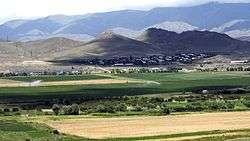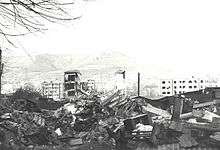Spitak
- For the nearby village, see Spitak (village).
Coordinates: 40°50′14″N 44°16′03″E / 40.83722°N 44.26750°E
| Spitak Սպիտակ | |
|---|---|
 | |
 Spitak | |
| Coordinates: 40°50′14″N 44°16′03″E / 40.83722°N 44.26750°E | |
| Country | Armenia |
| Marz (Province) | Lori |
| Founded | 17th century |
| Government | |
| • Mayor | Gagik Sahakyan |
| Area | |
| • Total | 57.6 km2 (22.2 sq mi) |
| Elevation | 1,650 m (5,410 ft) |
| Population (2011 census) | |
| • Total | 12,881 |
| • Density | 220/km2 (580/sq mi) |
| Time zone | (UTC+4) |
| Website | Official website |
| Sources: Population[1] | |
Spitak (Armenian: Սպիտակ), is a town in the northern Lori Province of Armenia. It is 96 km (60 mi) north of the capital, Yerevan, and 22 km (14 mi) west of the provincial centre, Vanadzor. Spitak was entirely destroyed during the devastating 1988 earthquake, and it was subsequently rebuilt in a slightly different location. As of the 2011 census, the population of the town is 12,881.
Etymology
At its foundation during the 17th century, the settlement was known as Hamamlu, meaning "bath"' in Persian, as the area had many historic baths. In 1949, it was renamed Spitak, meaning white in Armenian because of the presence of white limestone rocks in the area.
History
Historically, the area of modern-day Spitak was included in the Dzorapor (Armenian: Ձորափոր) canton of the historic Gugark province, the 13th province of Greater Armenia.
Spitak was founded as village called Hamamlu during the 17th century under the Persian rule over Eastern Armenia. The first residents of the village were Armenian migrants from the Iranina town of Khoy.
In 1828, the Erivan Khanate - including Hamamlu - was annexed by the Russian Empire. The region became officially part of the Russian Empire at the Treaty of Turkmenchay signed on 10 February 1828 between Imperial Russia and Qajar Persia. Administratively, the region was part of the Alexandropol uyezd within the Erivan Governorate of the Russian Empire.
In November 1918, Hamamlu became part of the newly formed Republic of Armenia. Following Armenia's sovietization in December 1920, Hamamlu was finally incorporated into Soviet Armenia on 11 February 1921.
Under the Soviet rule, Hamamlu was renamed Spitak in 1949. It was granted the status of a town in 1960 to become the centre of Spitak raion. In 1971, Spitak was granted the status of a town of republican subordination[2]

During the 1988 earthquake, Spitak was entirely destroyed and most of the population became homeless. After the collapse of the Soviet Union, the town was gradually rebuilt through the efforts of the Armenian government and the Armenian diaspora, with the assistance of many countries, including Uzbekistan, Switzerland, Russia, Austria, Finland, Norway, Italy, Germany, Czech Republic and Estonia.
Geography
Spitak covers an area of 57.6 km2 (22 sq mi) on the shores of Pambak River, at a height of 1650 meters above sea level. It is dominated by the Bazum mountains from the north and Pambak mountains from the south.
Spitak is characterized with extremely cold winter and mild summer. The annual precipitation level reaches up to 440 mm (17 in).
Demographics

Spitak has a population of ethnic Armenians who belong to the Armenian Apostolic Church. The regulating body of the church is the Diocese of Gougark, seated in Vanadzor. The church of Holy Resurrection opened in 2001 is the town's church.
At the beginning of the 19th century, many Armenian migrants from Khoy and Muş who were resettled in the town. In December 1988, around 4,000 people were killed in Spitak as a result of the devastating earthquake. After the breakout of the Nagorno-Karabakh War in 1988, around 500 Armenian refugees from Azerbaijan were resettled in Spitak.
Here is the population timeline of Spitak since 1831:
| Year | 1831 | 1897 | 1926 | 1939 | 1959 | 1979 | 1989 | 2005 | 2011 |
|---|---|---|---|---|---|---|---|---|---|
| Population | 466 | 3,004 | 4,078 | 5,035 | 3,740 | 14,536 | 3,740 | 15,000 | 12,881 |
Culture

Spitak has a cultural house, 3 public libraries, many cinema theatres as well as a municipal theater. It is also home to an ethnographic museum.
The cultural heritage of the town includes an archaeological site from the 2nd millennium BC, the ruins of an ancient settlement on the nearby Sardar hill from the 1st millennium BC, as well as a bridge on the Pambak river dating back to the 19th century.
The Spitak day is celebrated every year on July the 15th.
Transportation
The town of Spitak is an important hub for transportation in the Republic of Armenia. The M-3 Motorway that connects Yerevan with Vanadzor passes through the town. The M-7 Motorway the connects Gyumri with Vanadzor starts from Spitak.
The town is also home to the Spitak railway station, almost midway between Yerevan and Tbilisi.
Economy
Under the Soviet rule, Spitak became a major industrial hub in northern Armenia. The Spitak dairy factory was opened in 1937, while the sugar factory was opened in 1947.
However, after the earthquake, the town lost its significance as n industrial centre in Lori.
Currently, the town has a flour production plant and a building materials manufacturing company.
Education

As of 2015, Spitak has 7 public education schools, 1 boarding school and 7 kindergartens. The town is also home to a musical academy and a school of art.
A branch of the Yerevan electro-technical intermediate college is also operating in the town.
Sport
Football is the most popular sport in the town. FC Spitak represented the town in the domestic competitions between 1990 and 1998. However, like most Armenian football teams, the club was dissolved in 1999 due to financial difficulties.
The Spitak City Stadium is able to accommodate 5,000 spectators.[3]
Futsal, wrestling, boxing and weightlifting are also popular in the town.
Twin towns – Sister cities
Spitak is twinned with:
Gallery
-

Spitak landscape
-
Downtown Spitak
-

Inside the town
-

Spitak at dusk
See also
References
| Wikimedia Commons has media related to Spitak. |


